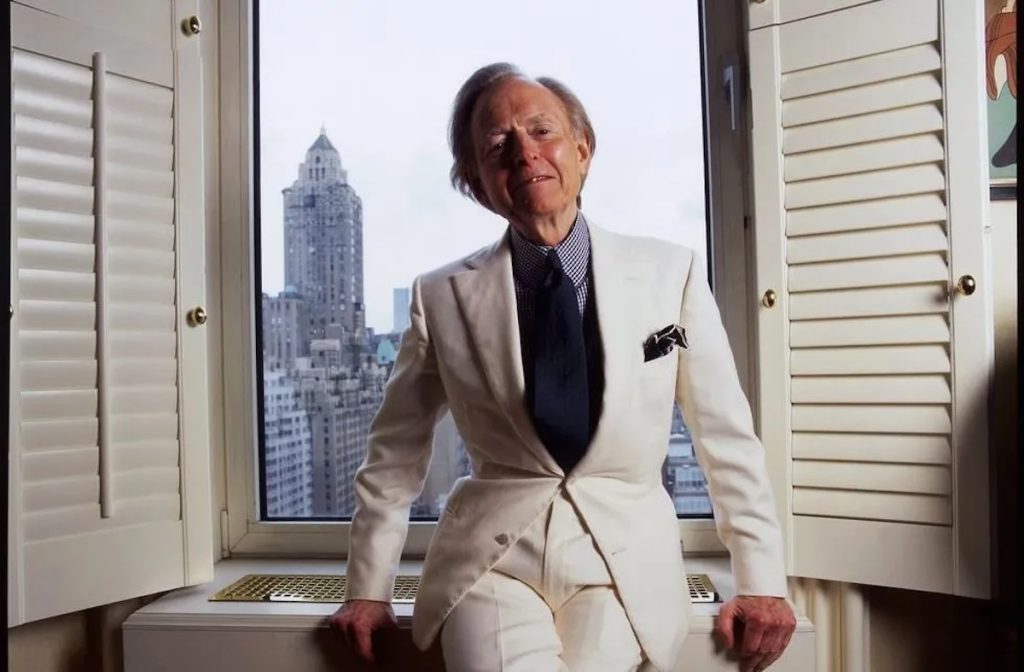Radical Wolfe begins the same way the 2015 Vanity Fair piece it’s based on begins: with author/journalist Michael Lewis (The Blind Side, The Big Short) recalling how he first got acquainted with the writings of Tom Wolfe. One day, young Lewis was looking through his father’s library, hoping to find something dirty. He took Wolfe’s Radical Chic and Mau-Mauing the Flak Catchers off a shelf and was soon howling with laughter. According to Lewis, this was the first time the lad realized this book was written by someone. “There was this boom,” he says, “this personality coming off the page.”
With Radical, the late, legendary journalist and novelist (who passed away in 2018) finally gets a spot alongside Hunter S. Thompson and Joan Didion in the winners’ circle of zero-fucks writers who changed journalism and literature so much in ‘60s, they now have their own documentaries chronicling how that happened.
Radical zips along as it lays out Wolfe’s journey from struggling newspaperman to superstar journalist. His first Esquire piece, “There Goes (Varoom! Varoom!) That Kandy-Kolored (Thphhhhhh!) Tangerine-Flake Streamline Baby (Rahghhh!) Around the Bend (Brummmmmmmmmmmmmmm)…,” was a hit with readers. (Doris Day and Hugh Hefner sent positive letters.) Stuck with writer’s block, he initially didn’t plan on writing the story, opting to type up 50 pages of notes to pass along to another writer. The editor went ahead and printed the notes.
By using literary techniques to make his nonfiction stories more vivid and verbose (the man loved wording out sounds, often using as many exclamation points as possible!!!!!), Wolfe set off the new wave — or the New Journalism wave, if you will —of rock-star reporters like Thompson (a well-known frenemy), Didion, George Plimpton, and Norman Mailer. He also transformed himself into a dapper dandy, rocking white silk tweed suits as a charming, disarming uniform. (I’m shocked no one in the doc brings up the wolf-in-sheep’s-clothing comparison.)
Basically a feature-length American Masters episode, Radical is standard-issue, but still satisfying. Producer/director Richard Dewey rounds up the usual selection of archival footage — interviews, news profiles, photographs — to weave together Wolfe’s life and times. Although Wolfe was Big Apple-based, he used most of his journalistic career making folk heroes out of the country’s flawed, underappreciated outliers: stock-car racer Junior Johnson, novelist/counterculture icon Ken Kesey, the pilots who made up the Mercury astronauts. (An off-camera Jon Hamm soothingly reads excerpts from the pieces Wolfe wrote on them.)
Unlike Thompson and Didion, who lived as recklessly as they wrote, Wolfe was really a sharp-dressed, family-loving square from Virginia. (His daughter Alexandra recalls how her old man once showed up to her school wearing a cape.) But the soft-spoken, Southern gentleman could be prickish with his pen. His years hanging out with uptight liberals at Yale turned him into a saboteur of the swanky set. He skewered posh, pretentious, East Coast socialites both real (in Chic, he infamously tore Leonard Bernstein a new one for organizing a benefit party for the Black Panthers) and imagined (his bestselling debut novel The Bonfire of the Vanities is pretty much a fuck-you to anyone who lives on Park Avenue).
Along with the footage, Dewey interviews admirers (Lewis, current Esquire writer Tom Junod, historian Niall Ferguson), old friends (fellow New Journalism pioneers Gay Talese and Gail Sheehy —RIP), even critical folk (former Black Panther Jamal Joseph has some things to say about Chic and Bonfire). Most of them convey the same message: even when Wolfe was at his shit-starting worst, you still had to respect the man. He may have always dressed like he was going to a brunch in the Hamptons but, as Radical Wolfe testifies, he would’ve preferred to eat the rich than eat with them.
B
“Radical Wolfe” is our Friday in limited release.

